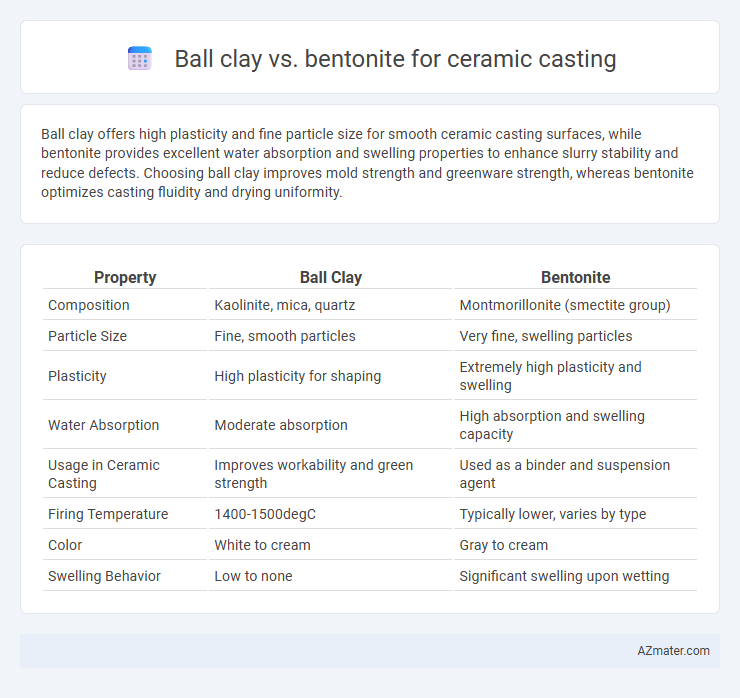Ball clay offers high plasticity and fine particle size for smooth ceramic casting surfaces, while bentonite provides excellent water absorption and swelling properties to enhance slurry stability and reduce defects. Choosing ball clay improves mold strength and greenware strength, whereas bentonite optimizes casting fluidity and drying uniformity.
Table of Comparison
| Property | Ball Clay | Bentonite |
|---|---|---|
| Composition | Kaolinite, mica, quartz | Montmorillonite (smectite group) |
| Particle Size | Fine, smooth particles | Very fine, swelling particles |
| Plasticity | High plasticity for shaping | Extremely high plasticity and swelling |
| Water Absorption | Moderate absorption | High absorption and swelling capacity |
| Usage in Ceramic Casting | Improves workability and green strength | Used as a binder and suspension agent |
| Firing Temperature | 1400-1500degC | Typically lower, varies by type |
| Color | White to cream | Gray to cream |
| Swelling Behavior | Low to none | Significant swelling upon wetting |
Introduction to Ball Clay and Bentonite
Ball clay and bentonite are essential materials in ceramic casting, each offering unique properties that influence the casting process. Ball clay, primarily composed of kaolinite, offers excellent plasticity and fine particle size, enhancing mold strength and surface finish. Bentonite, rich in montmorillonite, provides superior swelling properties and acts as a powerful binder, improving slurry suspension and mold permeability in ceramic casting.
Chemical Composition Differences
Ball clay primarily consists of kaolinite (20-80%), mica, and quartz, with a high alumina (Al2O3) content around 30-40% and silica (SiO2) ranging from 45-55%, offering high plasticity and whiteness ideal for ceramic casting. Bentonite is predominantly composed of montmorillonite clay mineral with a layered structure, containing higher sodium or calcium ions, lower alumina (15-25%), and higher swelling capacity due to its expansive lattice, making it less plastic but excellent for binding and suspension in slip casting. The distinct chemical composition differences, such as higher alumina and lower swelling in ball clay versus high smectite content and ion exchange capacity in bentonite, significantly influence their functionality and suitability in ceramic casting processes.
Physical Properties Comparison
Ball clay exhibits higher plasticity and finer particle size compared to bentonite, making it ideal for smooth casting surfaces and detailed ceramic molds. Bentonite offers superior swelling capacity and stronger water absorption, enhancing the suspension stability during ceramic slip casting. The lower shrinkage rate of ball clay reduces warping risks, whereas bentonite's higher cation exchange capacity improves mold release and reusability in ceramic production.
Plasticity and Workability
Ball clay offers higher plasticity than bentonite, making it ideal for ceramic casting processes requiring fine detail and smooth surface finishes. Bentonite provides excellent workability due to its strong binding properties and water absorption, enhancing the green strength of ceramic bodies during molding. Combining ball clay with bentonite often optimizes plasticity and workability, improving both the casting flow and structural integrity of ceramic products.
Shrinkage and Drying Behavior
Ball clay exhibits lower shrinkage rates during ceramic casting compared to bentonite, promoting dimensional stability in the dried product. Its finer particle size enhances plasticity, leading to more uniform drying and reduced cracking risks. Bentonite, while offering superior water retention and plasticity, tends to cause higher shrinkage and uneven drying, increasing susceptibility to warping and defects.
Impact on Casting Slip Rheology
Ball clay enhances casting slip rheology by improving plasticity and particle packing, resulting in smoother flow and better mold filling during ceramic casting. Bentonite significantly increases slip viscosity and yield stress due to its high swelling capacity, which can improve green strength but may reduce slip fluidity if overused. Selecting the right balance between ball clay and bentonite is crucial for optimizing slip rheology to achieve consistent casting performance and defect-free ceramic bodies.
Firing Characteristics and Final Strength
Ball clay exhibits a fine particle size with high plasticity, resulting in smooth casting surfaces and improved drying strength for ceramic casting applications. Bentonite offers superior swelling properties and enhanced green strength, which contribute to better mold stability but may cause higher shrinkage during firing. Ball clay produces a denser and stronger fired body with reduced porosity, whereas bentonite-fired ceramics tend to have increased brittleness and lower final strength due to their mineral composition and firing behavior.
Common Applications in Ceramics
Ball clay is frequently used in ceramic casting for its excellent plasticity and binding properties, making it ideal for shaping intricate forms and fine detail work in pottery and porcelain production. Bentonite, known for its strong swelling capacity and high ionic exchange, is commonly added to ceramic bodies to improve suspension and deflocculation in slurry processes, enhancing the casting slip's fluidity and particle suspension. Both materials are essential in ceramics: ball clay enhances workability and green strength, while bentonite optimizes slip consistency and drying characteristics in casting applications.
Cost and Availability
Ball clay is generally more affordable and widely available than bentonite, making it a preferred choice for ceramic casting when budget constraints exist. Bentonite, though more expensive, offers superior plasticity and suspension properties but may be harder to source in large quantities depending on the region. Ceramic manufacturers often select ball clay to reduce raw material costs while maintaining good casting performance.
Recommendations for Ceramic Casting
Ball clay offers superior plasticity and fine particle size, making it ideal for detailed ceramic casting molds and smooth surface finishes. Bentonite provides excellent suspension and water retention, enhancing slip stability and improving casting slip viscosity. For optimal ceramic casting results, a blend of ball clay for shape definition and bentonite for slip consistency is recommended.

Infographic: Ball clay vs Bentonite for Ceramic casting
 azmater.com
azmater.com